

From Lisa and Alex Lapella. Last month, we saw this article in Ceramic Arts Daily about making pottery using dropped slabs.
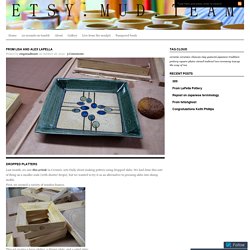
We had done this sort of thing on a smaller scale (with shorter drops), but we wanted to try it as an alternative to pressing slabs into slump molds. First, we created a variety of wooden frames. This set creates a large platter, a dinner plate, and a salad plate. We placed a frame on a ware board. Ours are smooth plywood covered in a fine canvas that would normally be used for stretching your own painting canvases. We lay the slab into the frame, gently lifting the edges so it begins to slump into the frame. We hold the board with frame and slab about chest height, take a big breath….. Making Clay Starfish and Sea Creatures Clay Project Lesson. How to Make a Clay Slab Tall Vase? Handbuilt Lesson. Decorating Low Fire Pottery with Slips, Underglazes, and Lusters. Glynnis Lessing » surface decoration. You are currently browsing the surface decoration category.

Sgraffito Workshop We had a delightful sgraffito workshop Sunday, October 11, at Lill. I started with the basic question of what is slip? Musing about mud: technical tuesday. For studio artists, production potters, students, educators, and hobbyists who love working with clay, this project-driven guide is an unmatched teaching tool and a fount of information and inspiration.

Focusing on various surface processes, and encompassing skills ranging from letterpress and printmaking to drawing and painting, it offers a wealth of techniques for transferring images onto clay vessels. Graphic Clay addresses such topics as staining sculptural work, glazing, brush application, screenprinting patterns on pottery, and slip, drawing, bisque, decal, stencils, and more. Pottery Tips and Techniques Rubbing Alcohol Technique. Single Firing in the Cone 5 - 7 Range. Make your own clay-sculpting loop tools-revised version (updated 7 Sept 09) The main materials you will need are brass or aluminium tubing (such as the K&S brand) and piano wire, which are available from good model shops, and bass guitar strings from music stores, or a guitar playing friend who may have a busted string.
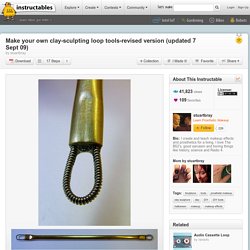
The rest is readily available from hardware stores. You will need " Brass or aluminium tubing" Piano wire" Bass guitar strings" 5 minute, 2-part epoxy resin" Wire wool or a dish-scouring pad" Pliers" Small adjustable pipe cutter, or a craft knife or blade (such as a Stanley knife) Bass strings are available in different thicknesses (I have no musical knowledge at all, so could not tell you what notes to pick. Choose a selection if in doubt). AMACO.com - American Art Clay Company - The source for creative people! In the June 2010 issue of Arts & Activities magazine by Jennifer Hoolihan, Ceramic Technician and Educator at Highwater Clays As we go about our day-to-day activities, birds are the most common form of wildlife we encounter on a regular basis.
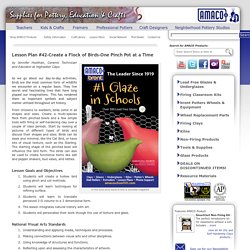
They live secret and fascinating lives that have long piqued our imaginations. This has rendered them as important symbols and subject matter utilized throughout art history. Pottery Tips and Techniques Rubbing Alcohol Technique. Obvara Pottery - Up in Smoke Pottery. Tips for Making, Firing, and Finishing Saggars and Saggar Fired Pottery in a Raku Kiln. Click to enlarge!
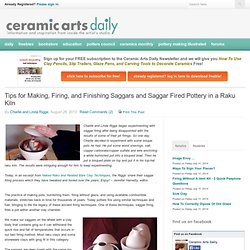
Firing and Finishing Warm up the kiln to 500°F (260°C) for 10 minutes. Increase the amount of fuel about every 10 minutes. When the kiln temp reads 1600°F (870°C), start a count-down timer for 20 minutes. Hold the temperature between 1600°F and 1700°F for 20 minutes. Considerations Temperature: The highest temperature that you reach will affect your firing.
Time and temperature together: The length of the firing at the top temperature is important. Amount of reduction material in the saggar: If you place too much reduction material (wood shavings) into the saggar, the pot will not oxidize and you will have a dark pot with little color. Position of your pyrometer in your kiln: The temperature in a raku kiln varies according to the position of the pyrometer in the kiln. Using Other Ingredients for Varied Effects. Foil_saggar.pdf. Aluminum Foil Saggar Firing. Aluminum Foil Saggar Firing Aluminum Foil Saggar Firing– Ken Turner Saggars are simply refractory containers designed to subject the ceramic work placed in it to an atmosphere of the makers’ choice.
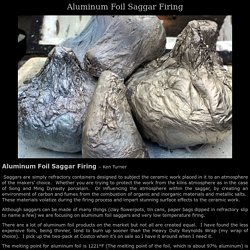
Whether you are trying to protect the work from the kilns atmosphere as in the case of Song and Ming Dynasty porcelain. Or influencing the atmosphere within the saggar, by creating an environment of carbon and fumes from the combustion of organic and inorganic materials and metallic salts. These materials volatize during the firing process and impart stunning surface effects to the ceramic work.
Slab and Coil Building. Arty tutorials. An Easy Way to Transfer Imagery to Pottery. Setting Up Manipulate the clay while it is still soft and pliable.

If making tiles, trim it to size (figure 5). Tip: Place the straight edge over your image as you cut, so if your hand slips, you won’t cut into your image. Place a thin sheet of plastic over the slab and rub the edges gently with your finger to produce a consistent rolled edge without marring the image (figure 6). If you prefer to allow the slab to dry slightly, place it on a piece of drywall and cover with plastic (figure 7).
Finishing You can easily carve the surface at the leather-hard stage. The sgraffito tool works well for detail work. Applying Color I prefer to apply commercial underglazes after bisque firing because at this stage, the image is essentially a contour drawing similar to a coloring book. You can fire the tile between each application of color, or in this case, I applied three colors at one time before firing. Glynnis Lessing » teaching. You are currently browsing the teaching category.
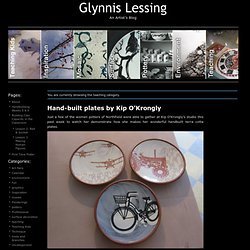
Hand-built plates by Kip O’Krongly. Clip 8 (of 13), Gakoigo pottery village, coil building.